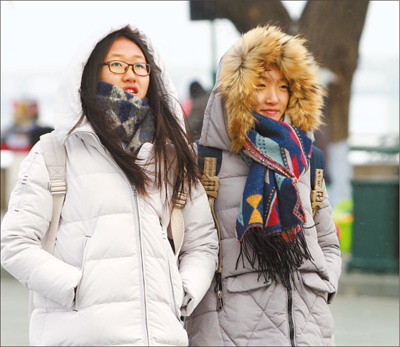


At 18: 00 on the 20th, the Central Meteorological Observatory issued a yellow warning for the cold wave: It is predicted that due to the influence of the cold wave, there will be large-scale gale and cooling weather from north to south in most parts of central and eastern China from the 20th to the 24th, and the average temperature will generally drop by 6-mdash; 10 degrees Celsius.
According to reports, this cold wave has the characteristics of large cooling range, wide precipitation range, strong cold air force and slow travel speed.
The cooling rate in the south is higher than that in the north, and the scope of winter in the whole country will be further expanded.
According to the news released by the Central Meteorological Observatory, affected by the cold wave, the temperature in the eastern part of northwest China, eastern and central North China, central and western Huanghuai, central and western Jianghuai, Jianghan, central and western Jiangnan, central and northern South China, northeastern Sichuan, eastern Chongqing and central and eastern Guizhou will drop by 12-mdash; At 14 degrees Celsius, the temperature drop in parts of southern Henan, western Anhui, most of Hubei, central and western Hunan and northeastern Guangxi can reach more than 16 degrees Celsius. The above areas are accompanied by 4-mdash; The northerly wind is 6, and the winds in the eastern and southern seas are 7-mdash; Level 9. In the early morning of the 22nd, the lowest temperature 0℃ line will be located in the central part of Huanghuai, and the lowest temperature in North China Plain will reach-3 -3— -10 degrees Celsius. The daily minimum temperature in some areas of North China Plain is close to the extreme value in the middle and late November.
At the same time, the Central Meteorological Observatory continued to issue a blue warning of blizzard. It is estimated that there will be heavy snow in parts of Beijing, northern Tianjin, northern Hebei, northeastern Shanxi and western mountainous areas of southern Xinjiang from 20: 00 on the 20th to 20: 00 on the 21st. Among them, there are blizzards (10-mdash; 12 mm), the above areas will add snow depth of 2-mdash; 5 cm, the local area can reach more than 8 cm.
"From the perspective of cooling range, due to the relatively low basic temperature in the northern region in the early stage, the cooling range in the southern region is larger than that in the northern region," said Zhang Tao, chief forecaster of the Central Meteorological Observatory. After the cold air, the minimum temperature in the southern region will not change much, and the minimum temperature will not recover obviously, but the maximum temperature in some areas will recover quickly during the day, so the temperature difference between day and night will be larger in some areas.
Does this round of cold air mean that China has officially entered winter?
Zhang Tao said that as China’s climate process gradually entered the winter, the force of warm and humid air flow gradually weakened. Meteorology, the average daily temperature for five consecutive days is below 10 degrees Celsius as the winter standard. At present, the area in winter in China is north of the Qinling Mountains and Huaihe River. After this round of cold air, the scope of winter in China will be further expanded, and the winter line will be pushed to the northern part of the south of the Yangtze River and the middle and lower reaches of the Yangtze River.
Strong cold air will affect the northern and southeastern waters of China on a large scale.
According to the National Ocean Forecasting Station, influenced by a strong cold air, it is predicted that there will be a strong temperate storm surge in Bohai Bay, Laizhou Bay and the northern coast of Shandong Peninsula from the afternoon of 20th to the morning of 22nd. From 21st to 26th, the Bohai Sea, the Yellow Sea, the East China Sea, the waters near Diaoyu Island, the Taiwan Province Strait and the northern part of the South China Sea will see a huge wave.
On the afternoon of the 20th, the National Marine Environmental Forecasting Center issued a 24-hour yellow storm surge warning: It is estimated that there will be 50-mdash in Bohai Bay from the afternoon of November 20th to the afternoon of 21st; 160 cm storm will increase water, and there will be 50-mdash in Laizhou Bay; 200 cm storm will increase water, and there will be 30-mdash along the northern coast of Shandong Peninsula; 80 cm storm increases water. Tidal stations in Caofeidian, Hebei, Huanghua and Tanggu, Tianjin will reach the local yellow warning tide level on the morning of 21st, tidal stations in Yangjiaogou and Weifang, Shandong will reach the local blue warning tide level on the afternoon of 21st, tidal stations in Jingtang Port, Hebei will reach the local blue warning tide level on the morning of 21st, and tidal stations in Longkou and Penglai, Shandong will reach the local warning tide level on the afternoon of 21st. The warning level of storm surge in Tangshan, Cangzhou, Tianjin and Weifang, Shandong Province is yellow, and the warning level of storm surge in Yantai, Shandong Province is blue.
This marine disaster process has a long time, a wide range and great intensity.
Experts suggest that relevant units should make preparations for defense deployment in advance, and relevant departments should conduct inspections and maintenance of seawalls, sluices and other facilities in a timely manner, and do a good job in strengthening seawalls and fishery breeding facilities in weak and dangerous areas.
Affected by cold air, air pollutants in Huanghuai area of North China will weaken and dissipate.
A few days ago, the air in some areas was heavily polluted, and many people still remember it: since November 16, the meteorological conditions in Beijing, Tianjin and Hebei and its surrounding areas have stabilized, the inversion temperature has increased, the humidity has increased, and the pollution diffusion conditions have been unfavorable, and some cities have successively experienced heavy pollution weather processes. The air quality in 30 cities has reached serious pollution and above, including Taiyuan, Linfen, Shijiazhuang, Kaifeng, Anyang and Xingtai. Beijing started the orange warning of heavy air pollution at 0: 00 on the 17th.
Then, when the cold wave strikes, can the blue sky come as scheduled?
According to the Central Meteorological Observatory, the smog weather in Huanghuai area of North China will be completely weakened and dissipated on the 21st with the arrival of cold air.
In addition, according to the forecast of China National Environmental Monitoring Center, 21st — On the 23rd, the diffusion conditions continued to be favorable. The air quality in most parts of Beijing-Tianjin-Hebei region was excellent, and slight pollution may occur in some areas. The primary pollutant was PM2.5.
On the 24th, as the wind direction gradually turned to the south, the diffusion conditions became worse, and pollutants tended to converge to the south-central part of Beijing, Tianjin and Hebei. The northern part of the Beijing-Tianjin-Hebei region is mainly excellent, while the central and southern parts of Beijing-Tianjin-Hebei, western Shandong, southwestern Shanxi and northern Henan are mainly light to moderate pollution, and some areas may have short-term heavy pollution. 25th — On the 26th, the diffusion conditions continued to be unfavorable, with moderate to severe pollution in central and southern Beijing-Tianjin-Hebei, central and western Shandong, northern Henan and southwestern Shanxi, among which serious pollution may occur in central and southern Beijing-Tianjin-Hebei and parts of western Shandong. On the 27th, the pollution situation eased and the pollution process ended due to the possible transit in the high-altitude trough area and the northerly airflow near the ground.
关于作者